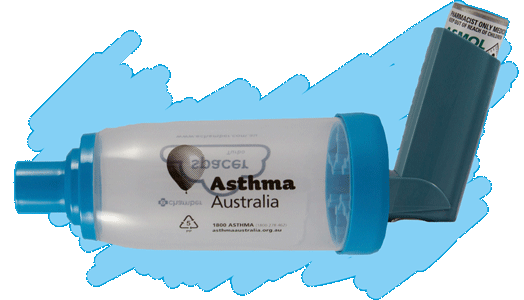
Asthma at Kindy
Having a young child with asthma can be frightening, and it’s important to know as much as you can about the condition and how it affects your child. Asthma Australia offer some pages to help you be informed and assist you in supporting young children with asthma here. You may also be interested in Where’s the Air? A Kids Guide to Asthma and Safety by Air Oasis.
Asthma is a condition of the airways. Children and Adults with asthma have sensitive airways in their lungs which react to triggers that set off their asthma. This makes it harder for them to breathe.
It is essential that our families and staff work together to achieve the best health and learning outcomes for children with asthma.
Here at Bonny Babes we ask our families to bring in your child’s spacer and inhaler in a named bag, container or pencil case. Your class teacher will keep this in the classroom to give to your child as directed by you or in case of an emergency. We also ask for a copy of your asthma plan which will be displayed in your child’s classroom and in our office so that staff are aware of any children that have asthma. If your child needs to use an inhaler due to sickness we ask that you fill out a medication form at reception when you arrive at Bonny Babes.

Below is information tips provided by Asthma Australia:
- Make a time to talk with the teacher or carer about your child’s asthma.
- Provide an up-to-date Asthma Plan from your child’s doctor
- Talk about what is normal for your child and their usual triggers, symptoms and medication
- Talk to other key staff
- Update the staff regularly
Update your child’s Asthma Plan:
At the start of each year
When their asthma or treatment changes
Establish ways to communicate
Find out the best ways to communicate with educators and carers, whether it is via email, phone or communication diaries.
Medication
Provide your child’s reliever medication and a spacer for use in an emergency
Include a mask for children under 5 years
Some children will use their reliever before physical activity
Make sure medications and devices are clearly labelled with your child’s name and date of birth and that the medication is in date.
Ways to help your child
Explain asthma to your child
Help them identify their triggers and symptoms
Help them with a routine for taking their asthma medication
Regularly check that they are using their asthma medication device properly
A child cannot always communicate their need for assistance. Tell your child what to do if they have an asthma attack and you are not there.
Further information
The below text was written by Debra Kay (Former CEO of Asthma Australia) in ECA’s Every Child magazine.
One in 10 children is diagnosed with asthma. It is one of the most common reasons children visit the doctor and go to hospital.
It is not fully understood why children develop asthma, though people with asthma often have a family history of asthma, eczema and hay fever (allergic rhinitis). There is no way of knowing whether a child will continue to have asthma, although there are some risk factors for continuing asthma in some children.
Asthma is different for everyone—people can have different triggers, symptoms and medications for their asthma, and these can also change. Young children can be prescribed asthma medication, depending on how frequently they experience symptoms and how unwell they become. All young children with asthma should have a blue reliever puffer, spacer and mask to relieve symptoms if they have an asthma attack. Some children also have preventer medications, which need to be used daily for the period specified by their doctor, even when the child is well.
All children with asthma should have a written plan which outlines their asthma care. All educators and carers should be trained to administer asthma first aid. This includes administration of salbutamol via the child’s own blue reliever puffer, or one from an asthma emergency kit. It’s best to use a spacer and mask to make sure the medication is delivered effectively.
For more information visit Asthma Australia and the Australian Institute of Health and Welfare.
This Article sourced from the Early Childhood Australia website.


